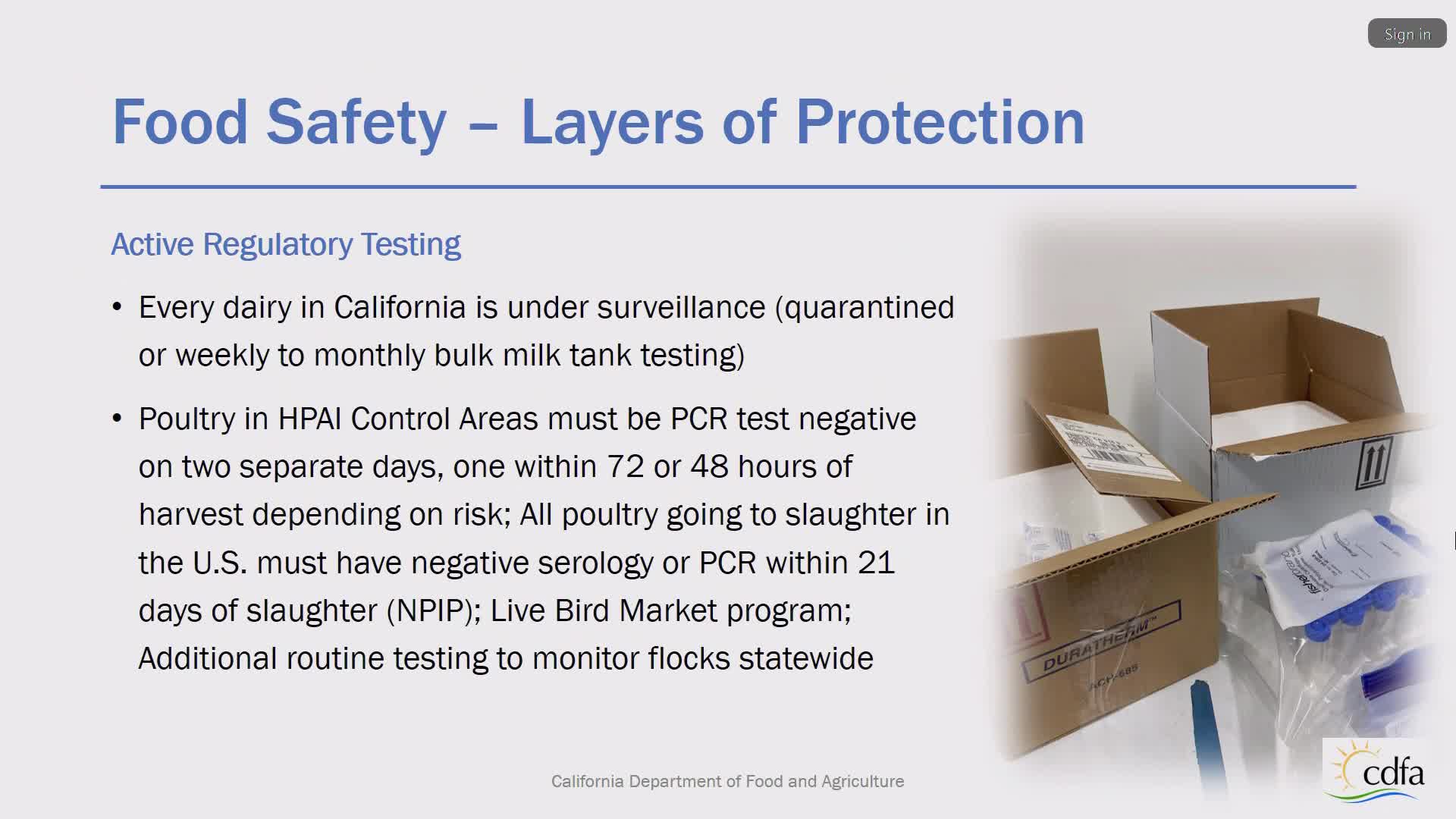California dairy and poultry sectors implement extensive testing and biosecurity measures amid virus outbreak
March 05, 2025 | California State Senate, Senate, Legislative, California
This article was created by AI summarizing key points discussed. AI makes mistakes, so for full details and context, please refer to the video of the full meeting. Please report any errors so we can fix them. Report an error »

In a recent joint hearing by the California State Senate focusing on health and agriculture, officials provided critical updates on the ongoing management of avian influenza (AI) and its impact on the state's dairy and poultry industries. The discussions highlighted the proactive measures being taken to control the spread of the virus, which has posed significant challenges to farmers and food safety.
Currently, every dairy in California is either undergoing testing or is under quarantine, a response to the unexpected discovery that the virus can infect cows. Officials emphasized the importance of ongoing testing to monitor the situation closely. In addition to dairy, poultry has long been known to be susceptible to AI, and stringent testing protocols are already in place. Poultry must be tested for the virus 21 days before slaughter, with increased testing frequency in high-risk areas.
The meeting underscored California's legal requirements for farmers to report any unexplained signs of disease, which is crucial for early detection and containment. The responsibility to ensure that sick animals do not enter the food supply falls on farmers, who must adhere to strict regulations.
A positive update was shared regarding the dairy sector, where quarantines are being lifted faster than they are being imposed, indicating progress in controlling the virus. Officials noted that over 600 biosecurity audits have been conducted to assess and improve safety measures on farms. Research efforts are also ramping up, with emergency funds allocated for studies aimed at understanding the virus's behavior and transmission among livestock.
The poultry industry has faced significant challenges, with the latest outbreak being described as the worst in the state's history. Despite improvements in biosecurity measures, the proximity of infected dairies has complicated efforts to keep the virus from poultry flocks. The price of eggs has surged as a direct consequence of these outbreaks, reflecting the broader economic impact on consumers.
Looking ahead, officials stressed the need for continued vigilance in biosecurity practices, ongoing testing, and efforts to reduce the virus load in the environment. The potential development of vaccines for both dairy cows and poultry was also mentioned as a future goal, which could provide a more effective means of managing outbreaks.
As California navigates these challenges, the commitment to safeguarding public health and the agricultural economy remains a top priority. The discussions from this hearing will inform ongoing strategies to protect both livestock and consumers in the face of evolving health threats.
Currently, every dairy in California is either undergoing testing or is under quarantine, a response to the unexpected discovery that the virus can infect cows. Officials emphasized the importance of ongoing testing to monitor the situation closely. In addition to dairy, poultry has long been known to be susceptible to AI, and stringent testing protocols are already in place. Poultry must be tested for the virus 21 days before slaughter, with increased testing frequency in high-risk areas.
The meeting underscored California's legal requirements for farmers to report any unexplained signs of disease, which is crucial for early detection and containment. The responsibility to ensure that sick animals do not enter the food supply falls on farmers, who must adhere to strict regulations.
A positive update was shared regarding the dairy sector, where quarantines are being lifted faster than they are being imposed, indicating progress in controlling the virus. Officials noted that over 600 biosecurity audits have been conducted to assess and improve safety measures on farms. Research efforts are also ramping up, with emergency funds allocated for studies aimed at understanding the virus's behavior and transmission among livestock.
The poultry industry has faced significant challenges, with the latest outbreak being described as the worst in the state's history. Despite improvements in biosecurity measures, the proximity of infected dairies has complicated efforts to keep the virus from poultry flocks. The price of eggs has surged as a direct consequence of these outbreaks, reflecting the broader economic impact on consumers.
Looking ahead, officials stressed the need for continued vigilance in biosecurity practices, ongoing testing, and efforts to reduce the virus load in the environment. The potential development of vaccines for both dairy cows and poultry was also mentioned as a future goal, which could provide a more effective means of managing outbreaks.
As California navigates these challenges, the commitment to safeguarding public health and the agricultural economy remains a top priority. The discussions from this hearing will inform ongoing strategies to protect both livestock and consumers in the face of evolving health threats.
View full meeting
This article is based on a recent meeting—watch the full video and explore the complete transcript for deeper insights into the discussion.
View full meeting
